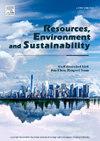矿业城市土地利用空间冲突动态机制研究——以新泰市为例
IF 12.4
Q1 ENVIRONMENTAL SCIENCES
引用次数: 0
摘要
随着资源的开采和转型发展,土地利用空间冲突对矿业城市发展的阻碍作用显著,凸显了探索土地利用空间冲突的动力机制对矿业城市可持续发展的重要性。本研究整合了LUSC的多维属性,构建了基于“要素-模式-效应”的LUSC评价框架,并对LUSC的动力机制提出了理论假设。以中国典型矿业城市新泰市为例,运用SEM模型分析了2000 - 2020年新泰市土地资源承载力的演化特征,探讨了土地资源承载力的影响机制。结果表明:矿业城市水土流失风险高发区集聚在矿城交织区,且随着过渡期的过渡,水土流失风险增长率显著提高;矿业城市土地利用变化的动力机制受自然和人为因素的共同驱动,并以人为因素为主。在影响路径上,生态环境、社会经济环境和资源开采对水土保持具有稳定而显著的直接影响。随着技术和政策的进步,自然环境对土地利用的制约逐渐减弱,对土地利用的影响多为间接影响。本研究提出了矿业城市土地利用效益动态机制的研究框架,为促进城市转型发展提供理论指导和建议。本文章由计算机程序翻译,如有差异,请以英文原文为准。

Dynamic mechanisms of land use spatial conflicts in mining cities: A case study of Xintai City, China
With resource extraction and transformational development, the hindering effect of land use spatial conflict (LUSC) on mining city development is significant, highlighting the importance of exploring the dynamic mechanism of LUSC for sustainable development. This study integrates the multidimensional attributes of LUSC, constructs a LUSC assessment framework based on “element- pattern-effect”, and proposes theoretical hypotheses on the dynamic mechanism of LUSC. Taking Xintai City, a typical mining city in China, as an example, we analyzed the characteristics of LUSC evolution from 2000 to 2020 and explored the impact mechanism of LUSC by using the SEM model. Results show that the high risk of LUSC in mining cities is clustered in mining-city intertwined zones, and the growth rate of LUSC risk increases significantly with the transition period. The dynamic mechanisms of LUSC in mining cities are mutually driven by natural and anthropogenic factors and are dominated by anthropogenic factors. On the impact pathway, ecological environment, socio-economic environment, and resource extraction have stable and significant direct effects on LUSC. With improvements in technology and policy, the constraints on land use imposed by the natural environment have gradually decreased, and the impacts on LUSC are mostly indirect. This study proposes a research framework for the dynamic mechanism of LUSC in mining cities to provide theoretical guidance and suggestions for promoting urban transformation and development.
求助全文
通过发布文献求助,成功后即可免费获取论文全文。
去求助
来源期刊

Resources Environment and Sustainability
Environmental Science-Environmental Science (miscellaneous)
CiteScore
15.10
自引率
0.00%
发文量
41
审稿时长
33 days
 求助内容:
求助内容: 应助结果提醒方式:
应助结果提醒方式:


